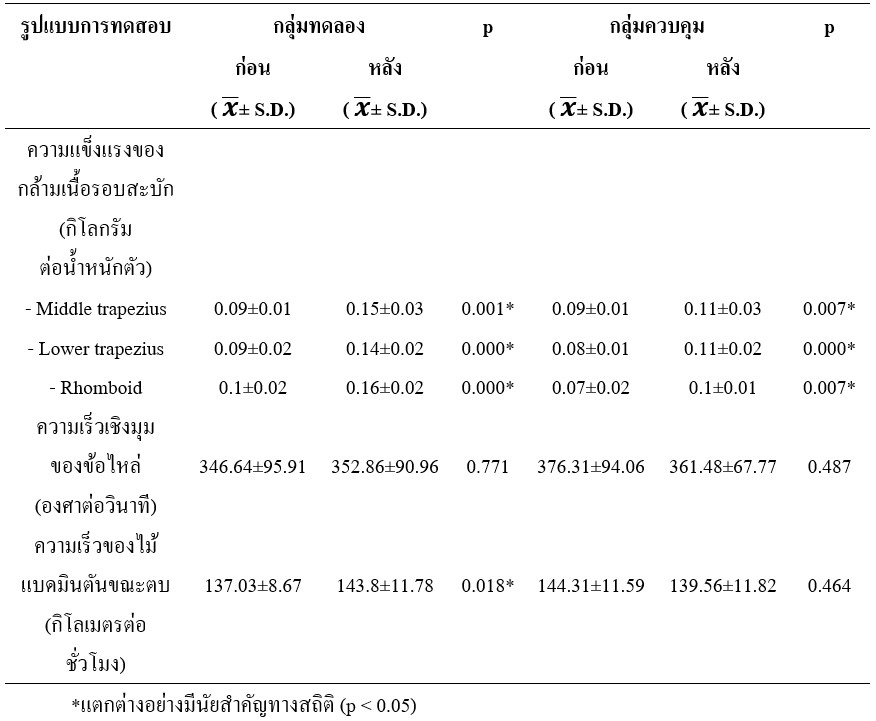EFFECTS OF SCAPULAR MUSCLES TRAINING ON RACKET VELOCITY DURING SMASH IN BADMINTON PLAYERS
Main Article Content
Abstract
Purpose: The purpose of this research was to study the scapular muscle training program effect to smash performance in badminton athletes.
Methods: The sample consisted of 16 badminton players between the ages of 14-18, both males and females, divided into 2 groups, 8 persons each group. The control group practicing regular badminton whereas the experimental group perform regular badminton training together with supplementing the scapula muscle training program for 3 days per week for 6 weeks. Test the strength of the scapula muscles, shoulder angular velocity and the badminton racket velocity before and after trained. Compare the average and Standard deviation before and after training and between groups by testing the t values. The level of statistically significant difference for analyses was set at p <0.05.
Results: (1) Both the experimental group and the control group significant increase in the strength of the scapula muscles but only the experimental group found a significant increase in the badminton racket velocity. (2) The experimental group showed a significant increase in the strength of the scapula muscles in both Middle trapezius, Lower trapezius and Rhomboid muscles (p = 0.01, 0.01 and 0.02 respectively).
Conclusion: The scapular muscle training program enhance the strength of the scapular muscle strength. It was found that the experimental group had more muscle growth around the scapular than the control group. Moreover there is a significant increase in the badminton racket velocity.
Article Details

This work is licensed under a Creative Commons Attribution-NonCommercial-NoDerivatives 4.0 International License.
References
Awatani, T., Morikita, I., Urata, T., Shinohara, J., & Tatsumi, Y. (2018). Correlation between isometric shoulder strength and racket velocity during badminton forehand smash movements: study of valid clinical assessment methods. Journal of physical therapy science, 30(6), 850-854.
Brahms, B.-V. (2014). Badminton Handbook: Training, Tactics, Competition: Meyer & Meyer Verlag.
Cohen, D. B., Mont, M. A., Campbell, K. R., Vogelstein, B. N., & Loewy, J. W. (1994). Upper extremity physical factors affecting tennis serve velocity. The American journal of sports medicine, 22(6), 746-750.
Dai, J., Zhong, J. P., & Wu, X. Q. (2009). The training of badminton smash techniques (Vol. 6): China School Physical Education.
Fennell, J., Phadke, C. P., Mochizuki, G., Ismail, F., & Boulias, C. (2016). Shoulder retractor strengthening exercise to minimize rhomboid muscle activity and subacromial impingement. Physiotherapy Canada, 68(1), 24-28.
Fernandez-Fernandez, J., & Ellenbecker, T. (2013). Effects of a 6-week junior tennis conditioning program on service velocity. Journal of sports science medicine, 12(2), 232.
Fleisig GS, D. C., Andrews JR. (1994). Biomechanics of the shoulder during throwing. New York: Churchill Livingstone.
Grezios, A. K., Gissis, I. T., Sotiropoulos, A. A., Nikolaidis, D. V., & Souglis, A. G. (2006). Muscle-contraction properties in overarm throwing movements. The Journal of Strength Conditioning Research, 20(1), 117-123.
Kennedy, K. (1993). Rehabilitation of the unstable shoulder. Oper Techniq Sports Med, 1, 311-324.
Kibler, B. (1998). The role of the scapula in athletic shoulder function. The American journal of sports medicine, 26(2), 325-337.
Kibler, W. B., Ludewig, P. M., McClure, P. W., Michener, L. A., Bak, K., & Sciascia, A. D. (2013). Clinical implications of scapular dyskinesis in shoulder injury: the 2013 consensus statement from the ‘Scapular Summit’. Br J Sports Med, 47(14), 877-885.
Lo, D., & Stark, K. (1991). Sports performance series: The badminton overhead shot. Strength Conditioning Journal, 13(4), 6-15.
Moore, K. L., Dalley, A. F., & Agur, A. M. (2013). Clinically oriented anatomy: Lippincott Williams & Wilkins.
Mueller, K. (1987). Statische und dynamische Muskelkraft. Frankfurt, Germany: Harri Deutsch.
Phomsoupha, M., & Laffaye, G. (2015). The science of badminton: game characteristics, anthropometry, physiology, visual fitness and biomechanics. Sports medicine, 45(4), 473-495.
Pink, M., & Perry, J. (1996). Biomechanics of the shoulder. Operative techniques in upper extremity sports injuries. St. Louis: Mosby.
Sakurai, S., & Ohtsuki, T. (2000). Muscle activity and accuracy of performance of the smash stroke in badminton with reference to skill and practice. Journal of sports sciences, 18(11), 901-914.
Seki, K. (1983). Movement analysis of badminton. Bull Waseda Univ, 15, 103-106.
Suttirak Nasome, A. S., Suebsai Boonveerabut (2013). The effect of Imagery and Modeling on Accuracy In Badminton Drop Shot. Faculty of Physical Education, 1, 35-43.
Tong, Y.-M., & Hong, Y. (2000). The playing pattern of world’s top single badminton players. Paper presented at the ISBS-Conference Proceedings Archive.
Treiber, F. A., Lott, J., Duncan, J., Slavens, G., & Davis, H. (1998). Effects of Theraband and lightweight dumbbell training on shoulder rotation torque and serve performance in college tennis players. The American journal of sports medicine, 26(4), 510-515.
Tsai, C.-L., Huang, K.-S., & Chang, S.-S. (2005). Biomechanical analysis of emg activity between badminton smash and drop shot. Paper presented at the The XXth Congress of the International Society of Biome-chanics Proceeding.
Tsuruike, M., & Ellenbecker, T. S. (2015). Serratus anterior and lower trapezius muscle activities during multi-joint isotonic scapular exercises and isometric contractions. Journal of athletic training, 50(2), 199-210.
Wooden, M. J., Greenfield, B., Johanson, M., Litzelman, L., Mundrane, M., & Donatelli, R. A. (1992). Effects of strength training on throwing velocity and shoulder muscle performance in teenage baseball players. Journal of Orthopaedic Sports Physical Therapy, 15(5), 223-228.
Zhao, X. (2007). Badmintonn: A course book in English-Chinese. Xiangtan, China.

